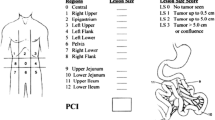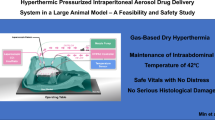Abstract
The role of loco-regional treatment of peritoneal carcinomatosis using intraperitoneal chemotherapy is still investigated. Actually, new technologies are suitable for these procedures, especially a new hybrid system using CO2 called Peritoneal Recirculation System (PRS-1.0 Combat). A HIPEC procedure in a porcine model using the PRS system was conducted. The objective of experimentation was to assess the distribution of liquid inside the abdomen, by using methylene blue instead of chemotherapy. Moreover, we positioned six different thermal probes in different abdominal regions inside the abdomen to measure the temperature during procedure. During the procedure, all thermal probes recorded an average temperature of 41.5°. At the end of infusion, the abdomen was emptied and then opened; the tracer distribution was recorded. No technical problems were recorded during the procedure. Good distribution of tracer was recorded. More studies are needed to investigate better this new technology.




Similar content being viewed by others
References
Cosentino F, Vizzielli G, Turco LC et al (2018) Near-infrared imaging with indocyanine green for detection of endometriosis lesions (Gre-Endo Trial): a pilot study. J Minim Invasive Gynecol. https://doi.org/10.1016/j.jmig.2018.02.023
Caruso S, Panella MM, Cianci S et al (2011) TOT does not affect the urethral sphincter innervation: a pilot study. Int Urogynecol J 22:739–742. https://doi.org/10.1007/s00192-011-1364-9
Vitale SG, Laganà AS, Noventa M et al (2018) Transvaginal bilateral sacrospinous fixation after second recurrence of vaginal vault prolapse: efficacy and impact on quality of life and sexuality. Biomed Res Int 2018:1–6. https://doi.org/10.1155/2018/5727165
Vitale SG, Sapia F, Rapisarda AMC et al (2017) Hysteroscopic morcellation of submucous myomas: a systematic review. Biomed Res Int 2017:1–6. https://doi.org/10.1155/2017/6848250
Vitale SG, Caruso S, Rapisarda AMC et al (2016) Biocompatible porcine dermis graft to treat severe cystocele: impact on quality of life and sexuality. Arch Gynecol Obstet 293:125–131. https://doi.org/10.1007/s00404-015-3820-0
Laganà AS, Vitale SG, Trovato MA et al (2016) Full-thickness excision versus shaving by laparoscopy for intestinal deep infiltrating endometriosis: Rationale and potential treatment options. Biomed Res Int 2016:1–8
Matarazzo MG, Cianci S, Rampello L et al (2013) Urethral sphincter innervation and clitoral blood flow after the transobturator (TOT) approach. Int Urogynecol J 24:621–625. https://doi.org/10.1007/s00192-012-1891-z
Tozzi R, Giannice R, Cianci S et al (2015) Neo-adjuvant chemotherapy does not increase the rate of complete resection and does not significantly reduce the morbidity of Visceral-Peritoneal Debulking (VPD) in patients with stage IIIC-IV ovarian cancer. Gynecol Oncol 138:252–258. https://doi.org/10.1016/j.ygyno.2015.05.010
Chiofalo B, Palmara V, Laganà AS et al (2017) Fertility sparing strategies in patients affected by placental site trophoblastic tumor. Curr Treat Options Oncol. 18:58
Rossetti D, Vitale SG, Tropea A et al (2017) New procedures for the identification of sentinel lymph node: shaping the horizon of future management in early stage uterine cervical cancer. Updates Surg 69:383–388. https://doi.org/10.1007/s13304-017-0456-6
Vitale SG, Rossetti D, Tropea A et al (2017) Fertility sparing surgery for stage IA type I and G2 endometrial cancer in reproductive-aged patients: evidence-based approach and future perspectives. Updates Surg. 69:29–34
Gueli Alletti S, Rossitto C, Cianci S et al (2016) Telelap ALF-X vs standard laparoscopy for the treatment of early-stage endometrial cancer: a single-institution retrospective cohort study. J Minim Invasive Gynecol 23:378–383. https://doi.org/10.1016/j.jmig.2015.11.006
Gueli Alletti S, Perrone E, Cianci S et al (2018) 3 mm Senhance robotic hysterectomy: a step towards future perspectives. J Robot Surg. https://doi.org/10.1007/s11701-018-0778-5
Rossitto C, Gueli Alletti S, Rotolo S et al (2016) Total laparoscopic hysterectomy using a percutaneous surgical system: a pilot study towards scarless surgery. Eur J Obstet Gynecol Reprod Biol 203:132–135. https://doi.org/10.1016/j.ejogrb.2016.05.007
Gueli Alletti S, Rossitto C, Perrone E et al (2017) Needleoscopic conservative staging of borderline ovarian tumor. J Minim Invasive Gynecol 24:529–530. https://doi.org/10.1016/j.jmig.2016.10.009
Gueli Alletti S, Rossitto C, Cianci S et al (2017) The Senhance™ surgical robotic system (“Senhance”) for total hysterectomy in obese patients: a pilot study. J Robot Surg. https://doi.org/10.1007/s11701-017-0718-9
Lagana AS, Vitale SG, De Dominici R et al (2016) Fertility outcome after laparoscopic salpingostomy or salpingectomy for tubal ectopic pregnancy A 12-years retrospective cohort study. Ann Ital Chir 87:461–465
Jaaback K, Johnson N, Lawrie TA (2011) Intraperitoneal chemotherapy for the initial management of primary epithelial ovarian cancer. Cochrane Database Syst Rev 11:CD005340. https://doi.org/10.1002/14651858.cd005340.pub3
Golse N, Bakrin N, Passot G et al (2012) Iterative procedures combining cytoreductive surgery with hyperthermic intraperitoneal chemotherapy for peritoneal recurrence: postoperative and long-term results. J Surg Oncol 106:197–203. https://doi.org/10.1002/jso.23062
Petrillo M, De Iaco P, Cianci S et al (2016) Long-term survival for platinum-sensitive recurrent ovarian cancer patients treated with secondary cytoreductive surgery plus hyperthermic intraperitoneal chemotherapy (HIPEC). Ann Surg Oncol 23:1660–1665. https://doi.org/10.1245/s10434-015-5050-x
Vitale SG, Marilli I, Lodato M et al (2013) The role of cytoreductive surgery in advanced-stage ovarian cancer: a systematic review. Updates Surg. 65:265–270
Gallotta V, Conte C, Giudice MT et al (2017) Secondary laparoscopic cytoreduction in recurrent ovarian cancer: a large, single-institution experience. J Minim Invasive Gynecol 25(4):644–650. https://doi.org/10.1016/j.jmig.2017.10.024
Rossetti D, Vitale SG, Gulino FA et al (2016) Laparoendoscopic single-site surgery for the assessment of peritoneal carcinomatosis resectability in patients with advanced ovarian cancer. Eur J Gynaecol Oncol 37:671–673. https://doi.org/10.12892/ejgo3234.2016
Vassos N, Förtsch T, Aladashvili A et al (2016) Repeated cytoreductive surgery (CRS) with hyperthermic intraperitoneal chemotherapy (HIPEC) in patients with recurrent peritoneal carcinomatosis. World J Surg Oncol. https://doi.org/10.1186/s12957-016-0804-x
Chiva LM, Gonzalez-Martin A (2015) A critical appraisal of hyperthermic intraperitoneal chemotherapy (HIPEC) in the treatment of advanced and recurrent ovarian cancer. Gynecol Oncol 136:130–135. https://doi.org/10.1016/j.ygyno.2014.11.072
van Driel WJ, Koole SN, Sikorska K et al (2018) Hyperthermic intraperitoneal chemotherapy in ovarian cancer. N Engl J Med 378:230–240. https://doi.org/10.1056/nejmoa1708618
Alyami M, Gagniere J, Sgarbura O et al (2017) Multicentric initial experience with the use of the pressurized intraperitoneal aerosol chemotherapy (PIPAC) in the management of unresectable peritoneal carcinomatosis. Eur J Surg Oncol 43:2178–2183. https://doi.org/10.1016/j.ejso.2017.09.010
Khosrawipour T, Khosrawipour V, Giger-Pabst U (2017) Pressurized intra peritoneal aerosol chemotherapy in patients suffering from peritoneal carcinomatosis of pancreatic adenocarcinoma. PLoS One. https://doi.org/10.1371/journal.pone.0186709
Sánchez-García S, Villarejo-Campos P, Padilla-Valverde D et al (2016) Intraperitoneal chemotherapy hyperthermia (HIPEC) for peritoneal carcinomatosis of ovarian cancer origin by fluid and CO2 recirculation using the closed abdomen technique (PRS-1.0 Combat): a clinical pilot study. Int J Hyperth 32:488–495. https://doi.org/10.3109/02656736.2016.1152515
Issels RD (2008) Hyperthermia adds to chemotherapy. Eur J Cancer 44:2546–2554. https://doi.org/10.1016/j.ejca.2008.07.038
Ferron G, Gesson-Paute A, Classe JM, Querleu D (2005) Feasibility of laparoscopic peritonectomy followed by intra-peritoneal chemohyperthermia: an experimental study. Gynecol Oncol 99:358–361. https://doi.org/10.1016/j.ygyno.2005.06.043
Fagotti A, Costantini B, Gallotta V et al (2015) Minimally Invasive Secondary Cytoreduction Plus HIPEC Versus Open Surgery Plus HIPEC in Isolated Relapse From Ovarian Cancer: a retrospective cohort study on perioperative outcomes. J Minim Invasive Gynecol 22:428–432. https://doi.org/10.1016/j.jmig.2014.11.008
Alletti SG, Vizzielli G, Lafuenti L et al (2018) Single-institution propensity-matched study to evaluate the psychological effect of minimally invasive interval debulking surgery versus standard laparotomic treatment: from body to mind and back. J Minim Invasive Gynecol. https://doi.org/10.1016/j.jmig.2017.12.007
Rossitto C, Cianci S, Gueli Alletti S et al (2017) Laparoscopic, minilaparoscopic, single-port and percutaneous hysterectomy: comparison of perioperative outcomes of minimally invasive approaches in gynecologic surgery. Eur J Obstet Gynecol Reprod Biol 216:125–129. https://doi.org/10.1016/j.ejogrb.2017.07.026
Bellia A, Vitale SG, Laganà AS et al (2016) Feasibility and surgical outcomes of conventional and robot-assisted laparoscopy for early-stage ovarian cancer: a retrospective, multicenter analysis. Arch Gynecol Obstet 294:615–622. https://doi.org/10.1007/s00404-016-4087-9
Padilla-Valverde D, Sanchez-Garcia S, García-Santos E et al (2017) Usefulness of thermographic analysis to control temperature homogeneity in the development and implementation of a closed recirculating CO2 chemohyperthermia model. Int J Hyperth 33:220–226. https://doi.org/10.1080/02656736.2016.1237679
Sánchez-García S, Padilla-Valverde D, Villarejo-Campos P et al (2017) Hyperthermic chemotherapy intra-abdominal laparoscopic approach: development of a laparoscopic model using CO2 recirculation system and clinical translation in peritoneal carcinomatosis. Int J Hyperth 33:684–689. https://doi.org/10.1080/02656736.2017.1302100
Vetvicka V, Laganà AS, Salmeri FM et al (2016) Regulation of apoptotic pathways during endometriosis: from the molecular basis to the future perspectives. Arch Gynecol Obstet 294:897–904
Laganà AS, Vitale SG, Salmeri FM et al (2017) Unus pro omnibus, omnes pro uno: a novel, evidence-based, unifying theory for the pathogenesis of endometriosis. Med Hypotheses 103:10–20. https://doi.org/10.1016/j.mehy.2017.03.032
Caruso S, Agnello C, Romano M et al (2011) Preliminary study on the effect of four-phasic estradiol valerate and dienogest (e2v/dng) oral contraceptive on the quality of sexual life. J Sex Med 8:2841–2850. https://doi.org/10.1111/j.1743-6109.2011.02409.x
Caruso S, Cianci S, Malandrino C et al (2013) Hyperandrogenic women treated with a continuous-regimen oral contraceptive. Eur J Obstet Gynecol Reprod Biol 171:307–310. https://doi.org/10.1016/j.ejogrb.2013.09.039
Caruso S, Cianci S, Cariola M et al (2017) Improvement of low sexual desire due to antiandrogenic combined oral contraceptives after switching to an oral contraceptive containing 17 β-estradiol. J Women’s Health 26:728–734. https://doi.org/10.1089/jwh.2016.5801
Caruso S, Cianci S, Vitale SG et al (2017) Effects of ultralow topical estriol dose on vaginal health and quality of life in postmenopausal women who underwent surgical treatment for pelvic organ prolapse. Menopause 24:900–907. https://doi.org/10.1097/gme.0000000000000851
Caruso S, Cianci S, Vitale SG et al (2018) Sexual function and quality of life of women adopting the levonorgestrel-releasing intrauterine system (LNG-IUS 13.5 mg) after abortion for unintended pregnancy. Eur J Contracept Reprod Health Care 23:24–31. https://doi.org/10.1080/13625187.2018.1433824
Funding
The work was not supported by any fund/grant.
Author information
Authors and Affiliations
Corresponding author
Ethics declarations
Conflict of interest
The authors declare that they have no conflict of interest.
Research involving human participants and/or animals
All procedures performed in studies involving animals were in accordance with the ethical standards of the institutional and/or national research committee and with the 1964 Helsinki Declaration and its later amendments or comparable ethical standards.
Informed consent
Not applicable for this type of study.
Rights and permissions
About this article
Cite this article
Cianci, S., Vizzielli, G., Fagotti, A. et al. A novel HIPEC technique using hybrid CO2 recirculation system: intra-abdominal diffusion test in a porcine model. Updates Surg 70, 529–533 (2018). https://doi.org/10.1007/s13304-018-0557-x
Received:
Accepted:
Published:
Issue Date:
DOI: https://doi.org/10.1007/s13304-018-0557-x




